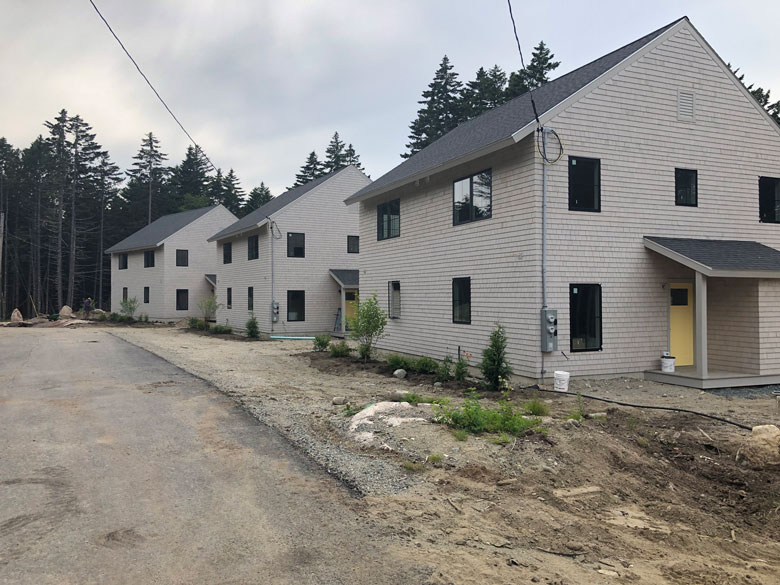Deer Isle and Stonington and Mount Desert Island are separated by a short hop across Blue Hill Bay. But if housing shortages are to be addressed, those two regions should tailor their work differently, and consider solutions within the context of a micro-region.
That was one of the takeaways from a March 20 panel discussion at the Stonington Opera House, part of a community Talk of the Towns series, this one devoted to affordable housing. The series concludes April 24 with a discussion of small-scale aquaculture.
Other recommendations from panelists on housing included the importance of:
• working to educate banks on financing unusual housing projects
• seeking private funding
• paying attention to the “visual cues” of public housing to avoid opposition from neighbors
• focusing on what moderator Linda Nelson called the “missing middle,” those whose incomes were not low enough to qualify for assistance, yet not wealthy enough to purchase in the area
Robert O’Brien of Camoin Associates, an economic development consulting firm, said part of the acute shortage of affordable housing is the result of “a decade of under-production” after the Great Recession that began in late 2008. Along with the steep drop in demand for houses, regulations for lending for housing tightened, further limiting construction.
“Nobody can afford to build housing now without subsidy.”
—Mark Primeau
One of the housing successes in the region is the recently completed ten-unit complex on Deer Isle, developed by the nonprofit Island Workforce Housing group.
Founder Linda Campbell said the Oliver’s Ridge project got off to a bumpy launch.
“We started it during COVID,” she said, with construction material costs skyrocketing and contractors busy elsewhere. Still, “We came in relatively close to what our budget was,” in large part because of “thousands of hours of volunteer work.”
Remarkably, no public funds were used.
“We raised $1.8 million in a year and a half,” Campbell said.
Jim Fisher, Deer Isle’s town manager, credited the “diverse skills on the committee” overseeing the project, which included an architect, someone working in finance, and a builder.
On MDI, an unusual collaboration succeeded in building workforce housing. Noel Musson of The Musson Group, a planning and permitting consulting firm, said the Island Housing Trust volunteer group wisely began by thinking island wide.
“Think about housing as a micro-region,” he advised, seeking solutions that may only work in one area.
Marla O’Byrne, executive director of Island Housing Trust, described how the effort to preserve Jones Marsh on MDI led to her group working with Maine Coast Heritage Trust to put the land into conservation easement while also building ten housing units. The houses may be purchased, but the land is leased.
“Nobody can afford to build housing now without subsidy,” said Mark Primeau of the Genesis Fund, a Maine nonprofit that loans money for housing, referring to private housing development companies.
Subsidies may be available for projects that serve households with less than 80% of the area median income, or AMI, which in Stonington, is about $68,000 for a family of four. Instead, Primeau said, communities want projects that serve families making 120% of AMI.
“We’re pretty dark in the winter now,” Nelson said of Stonington, where she serves as the town’s economic and community development director, meaning that year-round residents are few. Plumbers, electricians, and carpenters must commute to the island, she said, along with many of those working on lobster boats.
Fisher echoed Nelson’s description of Stonington lacking much year-round population.
“This is a very desirable place to be,” he said. “A lot of people want to be here, if only a few weeks a year.”
Nelson said that Stonington’s population has declined over the last decade, though the pandemic brought an influx, at least temporarily.
“We really would want them to stay,” she said.
The stigma associated with public housing projects was also discussed.
“One of the things we have to talk about out loud is how a neighborhood looks,” O’Brien said. The recent straw poll in Cumberland in which a 102-unit building project was rejected was cited as evidence of what is often an uphill climb in establishing subsidized housing.
Musson, who grew up on MDI, said people don’t like change, and so developers should carefully consider the “visual cues” so the buildings fit into the community.
“Litigation as planning is a terrible approach,” said Jim Fisher, town manager for Deer Isle. “It’s expensive.”
“You have to be above the fray,” Musson said of the offensive comments that often follow a proposal to build housing for people with lower incomes.
Even the jargon on the issue is charged. Panelists, responding to a question from the audience, said “affordable housing” is defined by federal income standards.
O’Byrne defined it as “housing for people who are under the median income.”
O’Brien’s definition was more concise and perhaps more clarifying: “attainable housing.”





